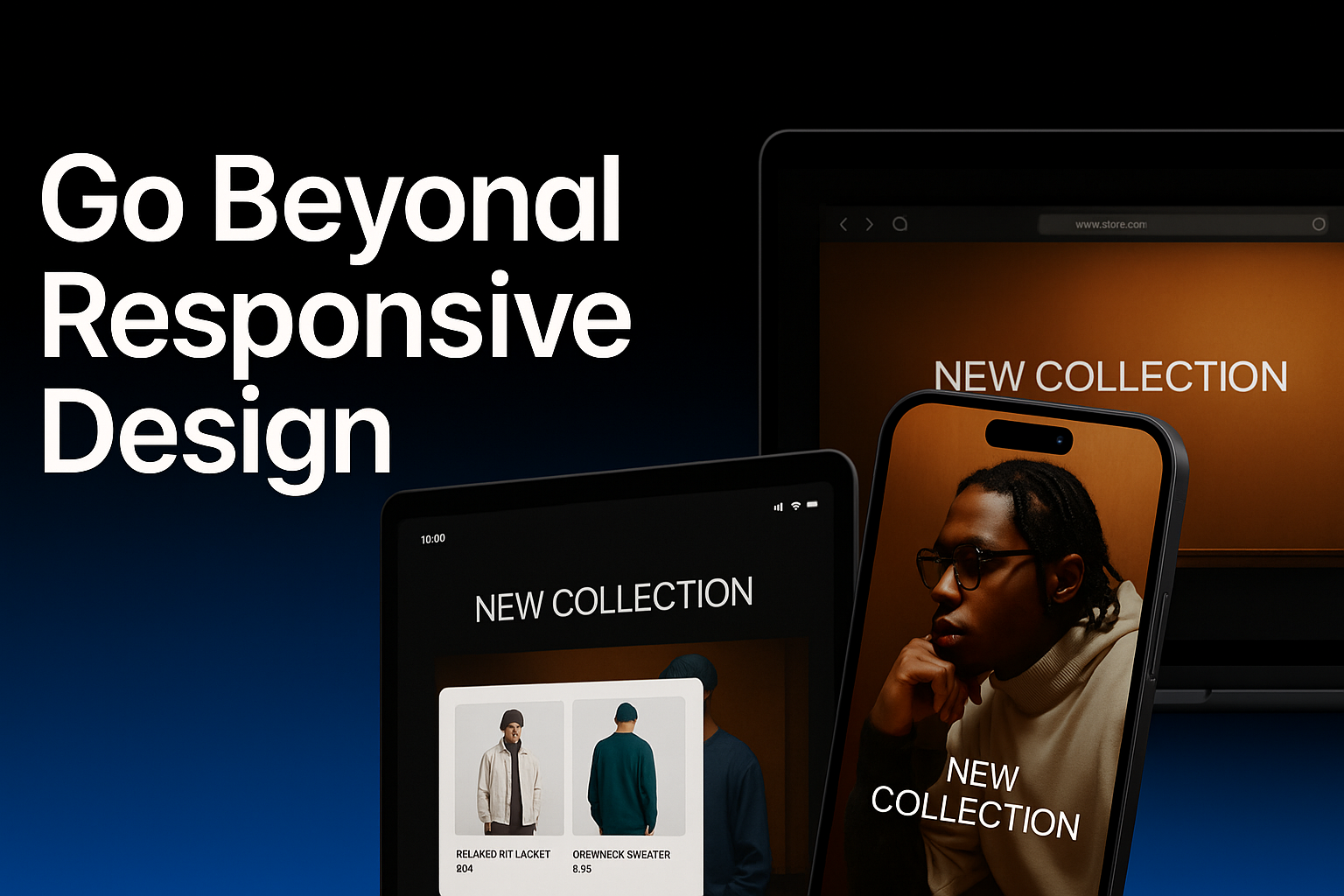Beyond Responsive Design: Why Your Mobile-Friendly Website Is Not Enough
In 2023, mobile commerce is no longer just a growing trend—it's the dominant force driving e-commerce growth. With mobile devices accounting for over 70% of e-commerce traffic and mobile sales continuing to rise each year, having a strategy for mobile shoppers is non-negotiable.
But is simply having a mobile-friendly website enough to capture this massive opportunity? The data suggests otherwise.

Mobile Commerce: The State of Play in 2023
Before diving into why mobile websites fall short, let's look at the current mobile commerce landscape:
- Mobile devices now account for over 70% of all e-commerce traffic
- Desktop usage has decreased from 55% to 41% in recent years, while mobile usage has grown from 37% to 56%
- Mobile shoppers spend 30% more per purchase than desktop users
- 79% of smartphone users have made a purchase online using their mobile device in the last 6 months
These statistics paint a clear picture: mobile is where your customers are. But the real question is—are you meeting them there with the right experience?
Mobile-Friendly Website vs. Mobile App: Understanding the Difference
Many e-commerce businesses believe that having a responsive website that works well on mobile is sufficient. Let's clarify the key differences:
What Is a Mobile-Friendly Website?
A mobile-friendly or responsive website adapts its layout and content to function on smaller screens. It's accessed through a mobile browser rather than being installed on a device. The site recognizes the user's device and adjusts its display accordingly.
What Is a Mobile App?
A mobile application is a dedicated software program downloaded and installed directly on a user's device. It's designed specifically for mobile operating systems like iOS or Android and operates natively on the device, often with access to system features like cameras, GPS, and push notifications.
Why Your Mobile-Friendly Website Falls Short
While having a responsive website is a crucial first step, here's why it's not enough to maximize your e-commerce growth potential:
1. User Experience Limitations
Mobile websites are inherently constrained by browser capabilities and connection speeds:
- Navigation constraints: Even the best-designed mobile sites require more taps and page loads than a well-designed app
- Performance issues: Mobile websites are significantly slower than apps, with average page load times of 15+ seconds on 3G connections
- Limited functionality: Browsers can't access many device features that enhance the shopping experience
When a customer has to pinch, zoom, or wait for pages to load, they're significantly more likely to abandon their purchase journey. Mobile apps eliminate these friction points with purpose-built interfaces designed for thumbs, not mouse pointers.
2. Engagement and Retention Challenges
The data shows a stark contrast in how users engage with mobile websites versus apps:
- Mobile app users spend 3x more time browsing than mobile web users
- App conversion rates average 3-5%, compared to 1-2% for mobile websites
- 85% of consumers prefer mobile apps to mobile websites when shopping
Why this dramatic difference? Apps create a dedicated space for your brand on the customer's device, allowing for:
- Personalized experiences based on user behavior and preferences
- Streamlined checkout processes with saved payment methods
- Offline browsing capabilities for product discovery
- Push notifications that bring customers back (with open rates up to 90%)
3. Limited Personalization Capabilities
Today's consumers expect tailored experiences. Mobile websites struggle to provide deep personalization because:
- They have limited access to user data and behavior patterns
- Session-based interactions make it harder to build comprehensive user profiles
- Cookie limitations in mobile browsers restrict tracking and personalization capabilities
Mobile apps, by contrast, can create highly personalized experiences by:
- Tracking detailed in-app behavior
- Storing preferences and purchase history locally
- Delivering personalized content based on browsing patterns
- Offering customized recommendations that truly resonate
4. Missing the Loyalty Loop
Perhaps the most significant limitation of mobile websites is their inability to foster the same level of brand loyalty:
- App users are 2.5x more likely to return to your store within 30 days
- The average app user completes 4.2x more transactions per year than a mobile web user
- Customers spend 37% more with brands after downloading their mobile app
The reason? Apps create a closed environment where your brand doesn't have to compete for attention. There are no browser tabs to switch between or distractions from competitors—just your products and your customer.
Essential Features Your Mobile-Friendly Website Cannot Deliver
Let's examine specific functionality that mobile websites simply cannot match:
1. Push Notifications
Push notifications are perhaps the most powerful engagement tool for mobile commerce, allowing you to:
- Alert customers about flash sales, restocked items, or abandoned carts
- Achieve open rates of 50-80% (compared to 20% for email)
- Trigger immediate action with timely, relevant messages
Mobile websites can only use browser notifications, which have lower opt-in rates and significantly reduced effectiveness compared to app push notifications. To learn more about implementing effective push notifications, check out our guides on effective push notification strategies and comparing push notifications with SMS marketing.
2. Offline Functionality
Mobile apps can store data locally, allowing customers to:
- Browse products without an internet connection
- View previously seen items and saved favorites
- Resume their shopping journey exactly where they left off
This capability is particularly valuable in areas with spotty connection or for customers who shop during commutes.
3. Device Feature Integration
Mobile apps can leverage device capabilities that websites cannot, including:
- Barcode/QR scanning for quick product lookups
- AR features for "try before you buy" experiences
- One-tap access to phone cameras for user-generated content
- Seamless integration with digital wallets and biometric authentication
These integrations create smoother, more engaging shopping experiences that drive conversion.
4. Performance and Speed
The performance gap between mobile websites and apps is substantial:
- Apps run 1.5x to 2x faster than mobile websites
- They require fewer data transfers once installed
- Apps store assets locally, eliminating the need to download the same elements repeatedly
This speed difference is critical when 40% of users abandon websites that take more than 3 seconds to load.
Building a Comprehensive Mobile Strategy
Rather than viewing mobile websites and apps as an either/or proposition, successful e-commerce businesses implement a strategic, multi-channel approach:
1. Start with a Mobile-Responsive Website
Your mobile website serves as your universal entry point. It should be:
- Fully responsive with intuitive navigation
- Optimized for speed with minimal load times
- Designed with simplified forms and large touch targets
- Equipped with streamlined checkout processes
This ensures that first-time visitors and occasional shoppers have a good experience regardless of how they find you.
2. Add a Purpose-Built Mobile App
Your mobile app should then elevate the experience for your most valuable customers by offering:
- Simplified authentication through biometrics or social logins
- Personalized product recommendations and content
- Streamlined one-click purchasing
- Exclusive app-only features, offers, and content
- Integrated loyalty programs and rewards
The goal is to provide such a superior experience that your regular customers prefer the app for all their interactions. Not sure if your business is ready for a mobile app? Check out our article on 7 critical signals your e-commerce business should transition to a mobile app.
3. Create a Seamless Cross-Channel Experience
The key to success is ensuring consistency across both channels:
- Synchronized shopping carts between app and website
- Consistent product information and pricing
- Shared account details and purchase history
- Unified loyalty program access
- Clear messaging about the additional benefits of the app
Measuring the Impact: Key Metrics That Improve with Mobile Apps
When implemented correctly, adding a mobile app to your existing mobile website strategy should positively impact:
- Customer Lifetime Value (CLV): App users typically spend 37% more over their customer lifetime
- Average Order Value (AOV): Mobile app orders average 10-15% higher value than mobile web orders
- Retention Rate: 30-day retention rates for apps average 14% vs. 3.4% for mobile websites
- Conversion Rate: Apps convert at 3x the rate of mobile websites on average
- Customer Engagement: Session duration, session frequency, and screen views per session all increase significantly with mobile apps
Conclusion: The Complementary Approach
While a mobile-friendly website is essential, it's just the beginning of an effective mobile commerce strategy. By complementing your responsive website with a purpose-built mobile app, you create a comprehensive ecosystem that meets customers at every stage of their journey.
The most successful e-commerce brands don't force customers to choose between web and app—they create integrated experiences that leverage the strengths of each channel. This approach not only drives immediate sales growth but builds the kind of lasting customer relationships that fuel sustainable business growth.
Ready to take your mobile commerce strategy beyond responsive design? Learn how Taptool can help you build a custom mobile app that complements your existing website and drives measurable business growth. Contact us today to schedule a demo.
